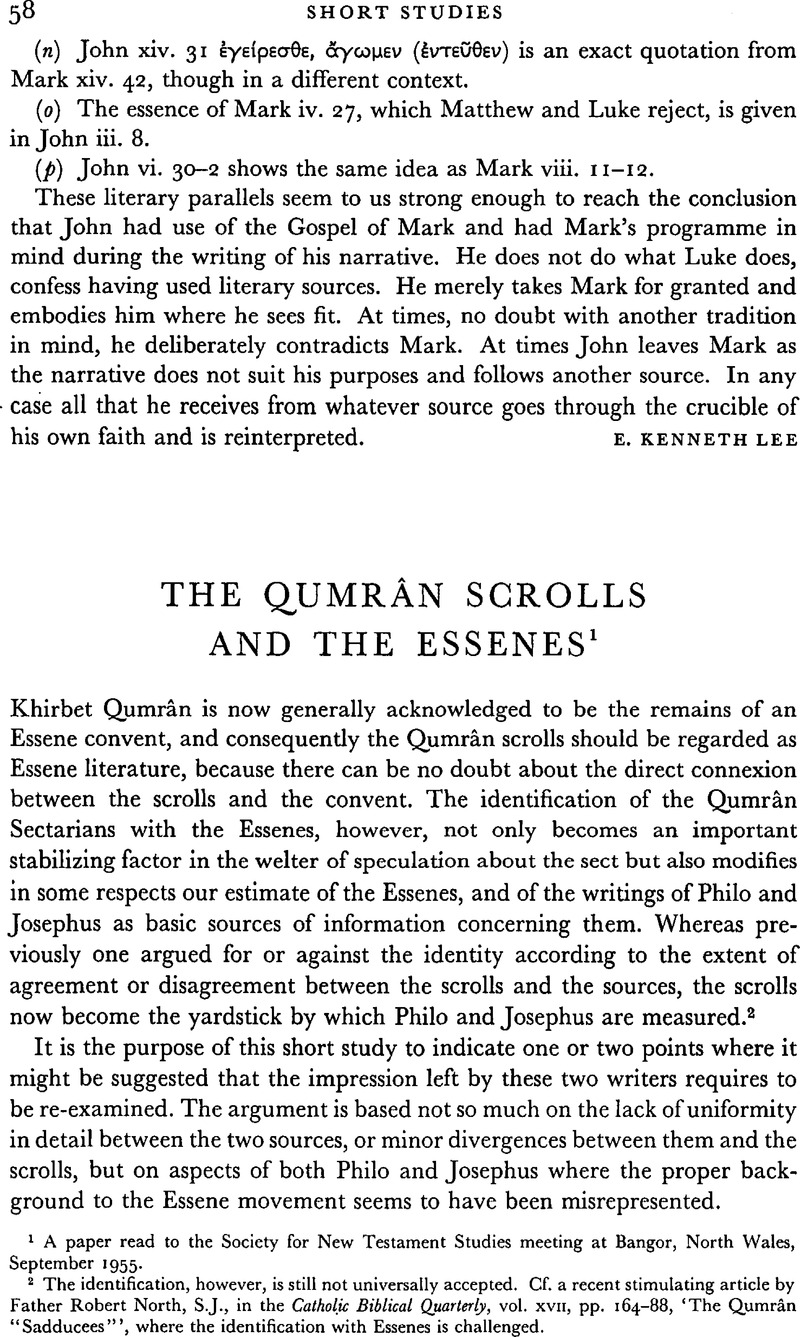No CrossRef data available.
Article contents
The Qumrân Scrolls and the Essenes1
Published online by Cambridge University Press: 05 February 2009
Abstract

- Type
- Short Studies
- Information
- Copyright
- Copyright © Cambridge University Press 1956
References
Page 58 note 2 The identification, however, is still not universally accepted. Cf. a recent stimulating article by Father Robert North, S.J., in the Catholic Biblical Quarterly, vol. XVII pp. 164–88, ‘The Qumrân “Sadducees”’, where the identification with Essenes is challenged.
Page 59 note 1 B.J. 11, p. 136. Cf. H. St J. Thackeray, Jewish War, I-III. (Loeb Classical Library. Josephus 11, pp 374–5 ff.)
Page 59 note 2 Antiq. xv, x, 5.
Page 59 note 3 Op. cit. p. 384. Cf. Lightfoot, Colossians, 8th ed., pp. 89f
Page 60 note 1 Quod Omnis Probus Liber Sit, par. 80 ff. Cf. Colson, F. H., Every Good Man is Free (Loeb Classical Library. Philo, IX), pp. 56–7 ff.Google Scholar
Page 60 note 2 Ibid. par. 80.
Page 61 note 1 The Habakkuk Scroll, col. ii, 11. 7 ff.
Page 61 note 2 ‘The Dead Sea crolls and the Old Testament Scriptures’, Bull. of the John Rylands Library, vol. xxxvi (September 1953), pp. 75ff. and separately.
Page 61 note 3 According to the Scriptures; see especially pp. 126ff.
Page 61 note 4 The Habakkuk Scroll, col. vii, 11. 7 ff.
Page 61 note 5 The Habakkuk Scroll, col. xi, 11. 2 ff.
Page 62 note 1 Sections from the Manual of Discipline, cols. iii–iv.Google Scholar
Page 62 note 2 Ibid.
Page 63 note 1 Col. viii, 11. 5 ff.
Page 63 note 2 Antiq. XVII, 19. Cf. Whiston, XVIII. 1. 5; J. Moffatt, E.R.E., ‘Essenes’, p. 399. In the discussion which followed this paper Principal Black reminded the conference that this passage had long been the subject of debate, and had recently been discussed by J. Thomas, Le mouvement baptiste en Palestine et Syrie (1935), pp. 12 ff. Textually, it has been established that certain manuscripts of the Josephus text (albeit few and late, i.e. eleventh, fourteenth and fifteenth centuries) omit the negative in the relevant phrase, thus giving the direct lie to the usual rendering. The point was noted by Naber in his edition of Josephus, 1888–93, but the only scholars to advocate this reading have been Bauer, in his article on Essenes in Pauly-Wissowa, and, particularly, Lagrange, Le judaïsme avant Jesus-Christ (1931); Thomas, after a thorough discussion of Lagrange's view, adopts the customary rendering. Dr Black writes me that ‘the point he was making was that in the light of the new texts there is evidence for the other view of the Josephus passage’. I would submit, nevertheless, that the statement of Josephus needs a greater modification than the simple deletion of the negative particle to bring his description to tally with the Essenes of Qumrân. The evidence of the scrolls, and particularly of the Damascus Documents, is that, in obedience to the Torah, sacrifices are to be ‘presented according to their exact rules’ (cf. C. Rabin, Zadokite Documents, p. 6, 1. 20; pp. 24f.), though there are complaints about the pollution of the sanctuary (p. 4, 1. 18; p. 5, 1. 7; p. 5, 1. 12). Otherwise the scrolls do not refer to sacrifice except in the negative sense, quite frequently asserted, that righteousness and fidelity are superior to flesh- and burnt-offerings. If that is what Josephus, too, had in mind he has expressed it with more than usual obscurity.
Page 63 note 3 Op. cit. par. 75.
Page 63 note 4 Charles, R. H., Pseudepigrapha, p. 790.Google Scholar
Page 64 note 1 Col. ix, II. 7 ff.




